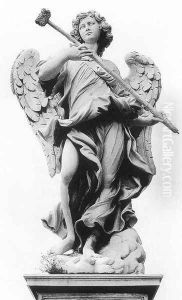Antonio Giorgetti Paintings
Antonio Giorgetti was an Italian sculptor of the Baroque period, born in 1635 and dying prematurely in 1669. His life and career unfolded during a particularly fertile period in the history of art, a time when the Baroque style was flourishing under the influence of its grand proponents such as Gian Lorenzo Bernini. Giorgetti, though not as universally recognized as Bernini, contributed significantly to the embellishment of Rome, the epicenter of Baroque art, with his sculptural works.
Giorgetti's training and artistic development took place in Rome, where he was deeply influenced by the prevailing Baroque aesthetics and the works of contemporaneous artists. He was particularly associated with the studio of Bernini, one of the era's most commanding figures in art and architecture. Working under Bernini's guidance, Giorgetti adopted a dynamic and expressive style, characterized by dramatic gestures, intricate details, and a strong sense of movement—hallmarks of the Baroque ethos.
Among Giorgetti's notable works is his contribution to the Church of Santa Maria della Vittoria in Rome, where he executed sculptures that demonstrate his mastery of form and emotion, contributing to the church's reputation as a jewel of Baroque architecture and sculpture. His works are celebrated for their vivid expressions and the technical skill evident in the handling of marble, showcasing his ability to imbue the stone with a sense of life and vibrancy.
Despite his premature death at the age of 34, Antonio Giorgetti left behind a legacy that reflects the spirited innovation and aesthetic values of the Baroque period. His sculptures continue to be admired for their emotional intensity and technical prowess, securing his place in the annals of art history as a talented sculptor who contributed meaningfully to the artistic heritage of 17th-century Italy.

